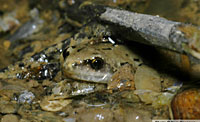Online Field Guide to The Reptiles and Amphibians of Arizona



Maricopa County, AZ
 Santa Cruz Co., AZ |
| WESTERN NARROW-MOUTHED TOAD Gastrophryne olivacea |
|
|
DESCRIPTION: Adult Western narrow-mouthed toads measure from 0.75-1.6 inches snout-vent length. The species has smooth, thick skin; the head is small and pointed to facilitate burrowing; and in Arizona specimens, a fold of skin crosses the head just posterior to the eyes. The hind legs are short and stout, and the fingers and toes are not webbed. The toe tips are rounded and tapered. Colorations vary in adults from brown, brownish-gray, to gray. Young are camouflaged with dark leaf patterns that grow paler with age. Adult males tend to have a dark, yellow throat. Tadpoles grow to about 1.5 inches, are grayish-tan dorsally, and have dark tail tips. The eyes are spaced far apart on the sides of the head, and the labial tooth rows found in the mouth parts of other Arizona tadpoles are absent. DISTRIBUTION: In Arizona, the species has been found from Patagonia westward to the Santa Cruz River near Rio Rico and Tucson, into the Pajarito/Atascosa ranges, near Robles Junction, the Vekol Valley, and the Tohono O’odham Nation. It has also been found near Lukeville in Organ Pipe Cactus National Monument. HABITAT: In the western portion of its Arizona range, the Western narrow-mouthed toad occurs as a valley bottom species in the Sonoran Desert, often in the same general habitats as the Sonoran green toad and Lowland burrowing treefrog. However, in the Pajarito/Atascosa complex and near Patagonia, the species occurs in oak/mesquite/grassland communities, often in hilly or rolling terrain. Also known from the Santa Cruz River. BEHAVIOR: This secretive toad burrows into crevices and under rocks and bark that surround ephemeral streams and flooded areas. They may also be found near ant and termite nests. Outside of the summer monsoon period they remain dormant in subterranean retreats. REPRODUCTION AND CALLS: An explosive breeder, Western narrow-mouthed toads breed in Arizona during the summer monsoons from June to September. In the desert, breeding sites are often muddy stock tanks or ephemeral sloughs surrounded by a thick growth of mesquites, but in the mountains, the species also breeds in ephemeral streams and springs. The male’s advertisement call is a high-pitched nasal whine or buzz. Ventral glands in the male aid in amplexus by creating a sticky surface so that they stay attached to the female. Females lay from several hundred to as many as 2,100 eggs in packets of 100-200. Egg masses often appear as films on the water’s surface, but may become attached to vegetation. Eggs hatch in 2 days and metamorphosis occurs in 28-50 days. DIET: Western narrow-mouthed toads eat a variety of small invertebrates, but the majority of prey items are ants, termites, and small beetles. REMARKS: Breeding aggregations can be located by listening for chorusing males, but the call is easily confused with that of the Sonoran green toad. Individual calling males can be frustrating to find because the acoustics of the call make pinpointing the call’s precise location very difficult. Brennan, T.C., & Holycross, A.T. 2006. A Field Guide to Amphibians and Reptiles in Arizona. Arizona Game and Fish Department. Phoenix, AZ. Chrapliwy, P.S. 1956. Extensions of known range of certain amphibians and reptiles of Mexico. Herpetologica. 12(2): 121-124. Degenhardt, W.G., C.W. Painter, and A.H. Price. 1996. Amphibians and Reptiles of New Mexico. University of New Mexico Press, Albuquerque, NM. Nelson, Craig E. 1972. Gastrophryne olivacea. Catalogue of American Amphibians and Reptiles. (122):1-4. Sredl, M.J., and K.J. Field. 2005. Gastrophryne olivacea Hallowell, 1857 “1856”, Western narrow-mouthed toad. Pages 503-506 in M.J. Lannoo (ed), Amphibian Declines: The Conservation Status of United States Species. University of California Press, Berkeley, CA. Sullivan, B.K., R.W. Bowker, K.B. Malmos, and E.A. Gergus. 1996. Arizona distribution of three Sonoran Desert anurans: Bufo retiformis, Gastrophryne olivacea, and Pternohyla fodiens. Report to the Arizona Game and Fish Department, Phoenix, AZ.
|
|
Visit Partners in Amphibian and Reptile Conservation:


HOME
Copyright © 2023, Arizona Game and Fish Department. All rights reserved.
If you make use of the textual contents of this site in reports, publications, etc. please cite and credit the author(s) and photographer(s). All photos on this website are copyrighted. However, those found in the species account section may be used for any noncommercial scientific, educational, or conservation purposes provided that photographs are not altered and continue to bear the copyright symbol and name of the photographer. Please contact the photographer regarding commercial use of copyrighted photographs.











